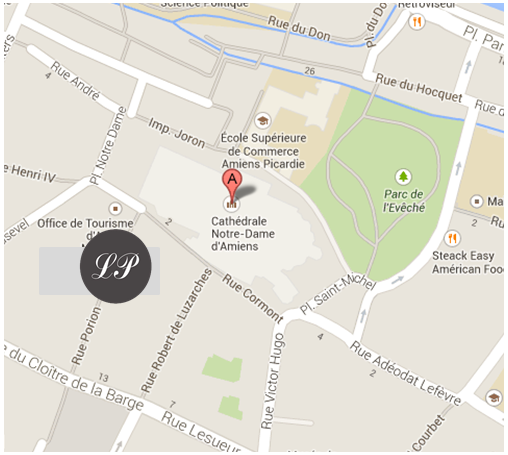Priory's history
The place of the Cathedral and the Priory in the medieval town
Amiens is located on the southern slope of the Valley of the Somme, on the last alluvial terrace. The nature of the terrain and the implantation of the city play a very important role in the construction of Notre Dame Cathedral since the limestone is an abundant building material and the presence of the amount allows the delivery of construction materials.
The Cathedral Notre Dame of Amiens, built mostly in the 13th century, between 1220 and 1288, is not a Holy Ark floating in the middle of the waters. It fits physically, in an urban setting that surrounds it and the pupil. In the heart of the city, the colonial quarter him offers both this symbolic protection and a framework that comes alive to the rhythm of the vagaries of the Gothic building.
The colonial neighborhood or neighborhood of the canons represents a quadrangular set formed of four streets, known as cloisters, South of the Cathedral

Amiens to 1130, a few years after the establishment of the commune, test of restitution of the
urban topography (J. Estienne et F. Vasselle, Le Bel Amiens, Ed. Martelle, Amiens, 1991, p.77.
With the kind permission of M. Vasselle).
There are thus the (1) Rue Notre Dame or the first cloister (current street Cormont), the oldest. At the corner of Notre Dame cloister, (2) the cloister of the clock (current street drift but also rue the Priory and the Residence Le Prieuré) named after late clock located on the southern flank of the Cathedral. With his profile curve, This street remains relatively narrow ; It houses in addition to hotels in Canon rebuilt in stone in the 18th century cloister, control of the children's choir and refectory.
(3) The cloister of the Barge continues along an East-West axis occupying the southern part of the cloister. (4) Cloitre Saint Nicolas (current Robert de Luzarches) Closes this canonial quadrilateral.
The street of the cloister of the clock (1) is renamed today rue Porion which takes its name from Louis PORION born in Amiens on August 1 1805 and death the 9 January 1858 who was the representative of the constituent assemblies and legislative, general counsel, Knight of the Legion of honour and Mayor of Amiens of 5 March 1848 to the 5 December 1851. He was buried in the Madeleine cemetery.
The Charter of Thierry Ier, evokes, in the 11th century, the depreciation of 30 colonial houses. Although their existence is no doubt earlier, It should be until the 12th century that the designations of colonial houses multiply. Inside the boundaries of the old colonial district, There are 40 homes which most are destined for housing of the canons.
Instead, and place of the hotel Le Prieuré was one of its residences of Canon.
These houses, by far the most beautiful and among the largest in the city make this district a vibrant showcase of the colonial power.

The Priory located in the shadow of the towers of the Cathedral, is a, part of the 17th century, with older foundations, the bases of the XII and XIII century.
It is part of the building remodeled in the 17TH century the islet called Enclos du Chapitre. This is where that resided the canons of the Cathedral, each occupying a building with its domesticity.
The Revolution of 1789 disrupted the multi-secular hum of chapter life.
After the Revolution, the canons of the chapter restored by the Concordat, settled on the side the place Saint Michel.
The Priory was purchased and occupied by three successive families during the 19th century. Two of these families are in the Armorial Picard : one of them, at the time of the Gothic Revival craze, did develop in this style buildings overlooking the courtyard, including a chapel that still.
The Le Prieuré name then given to the hotel is the term currently bears. It seems that due to the age, one could call it : THE HOSTELLERIE DE CHAPTER
The facade of the hotel Le Prieuré is also responsible for a little more recent history. Albéric de Calonne in his history of the city of Amiens wrote :
"Military order of March 1 1768, that required to number the houses, to facilitate the distribution of housing for troops, receives its execution, in 1775 ». Highlight, the author gives us some examples of homes that still bear this numbering.
Jacques Foucart and M.Leclercq did the same exercise, a century after and give the results of their research in the SAP of the 3rd quarter bulletin 1998. It begins with the Rabuissons Street, today : Rue de la République which was numbered 1 to 35. There is still the number «» 09 "that became the 56 Rue de la République. The most prolific Street is the drift with 5 numbers. Numbers 4644 and 4645 correspond to the numbers 8 and 10 current. The number 4639 corresponds to the hotel Le Prieuré.





 Free Wifi
Free Wifi Tablette iPad
Tablette iPad Non-smoking hotel
Non-smoking hotel Pets allowed
Pets allowed Cot, changing table
Cot, changing table Luggage storage on demand
Luggage storage on demand See all services
See all services